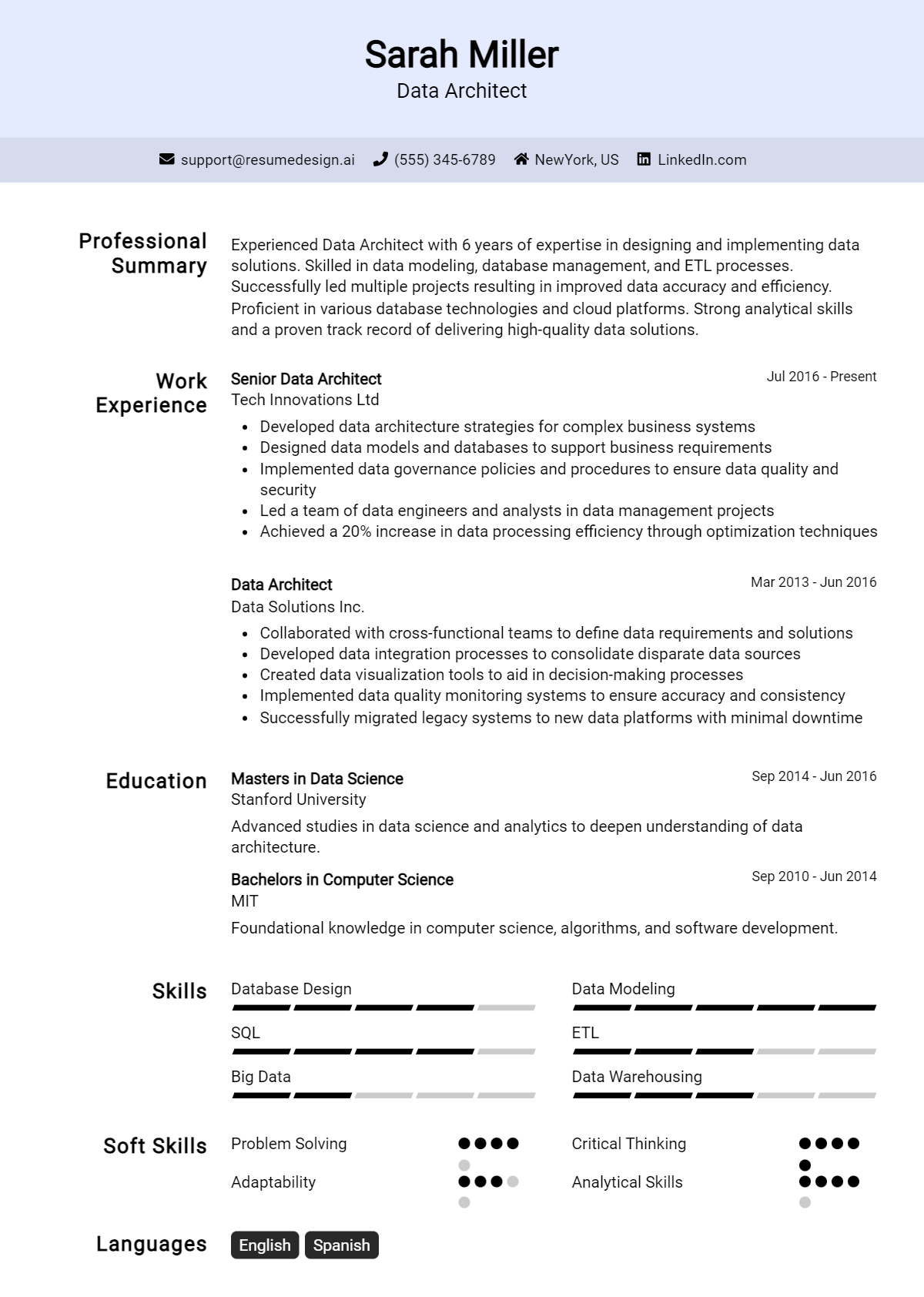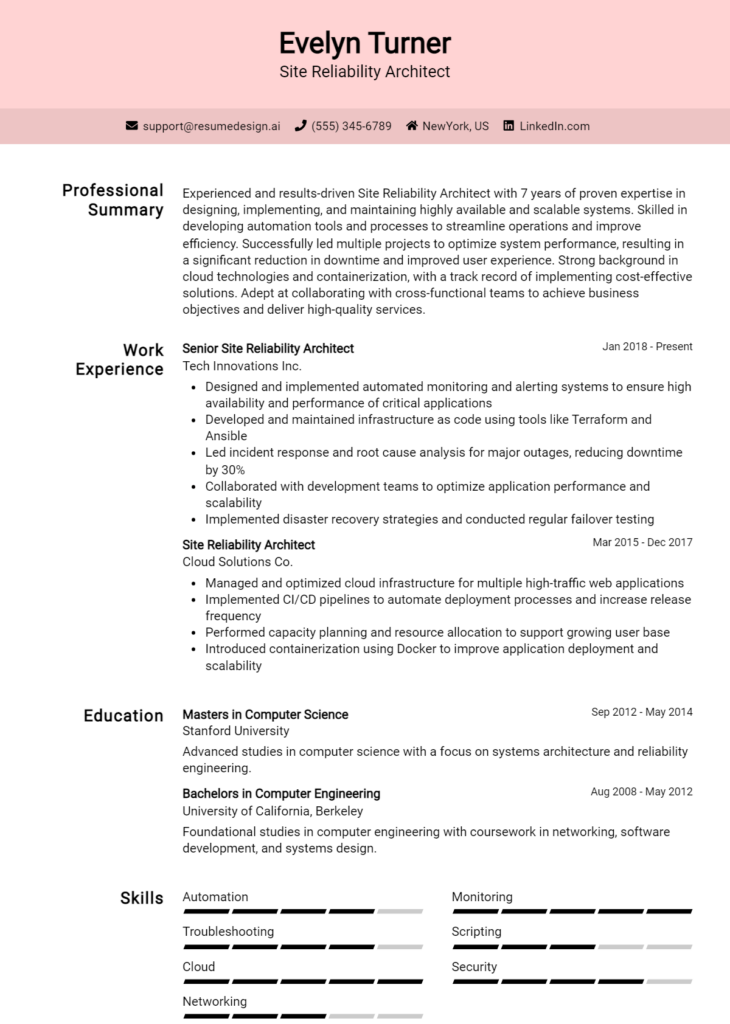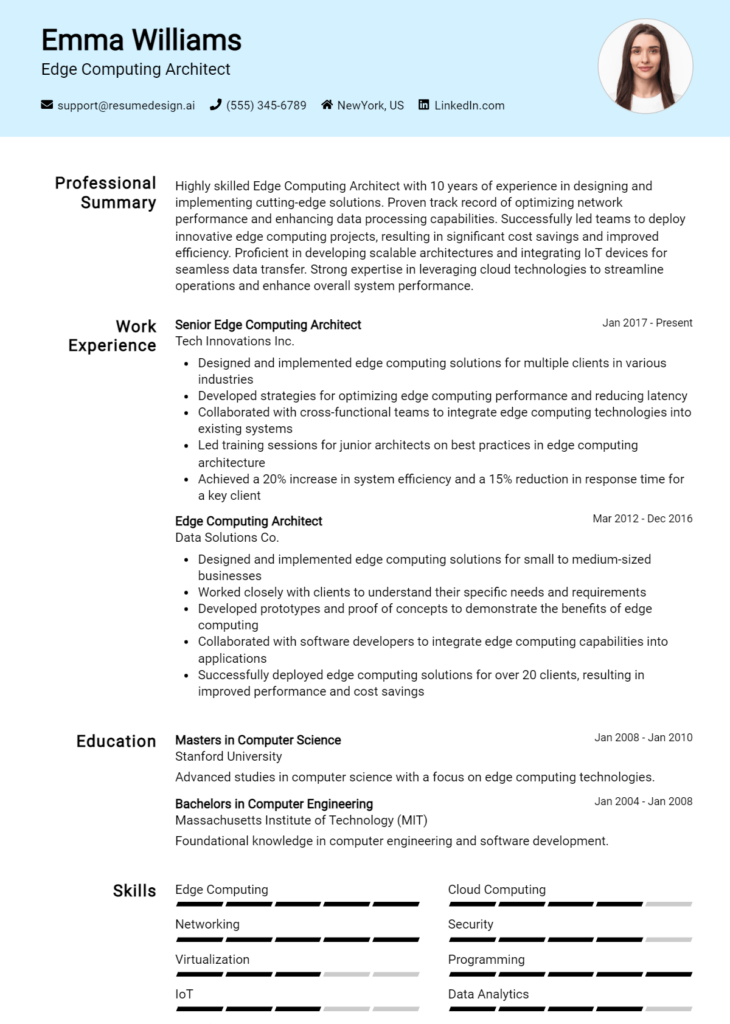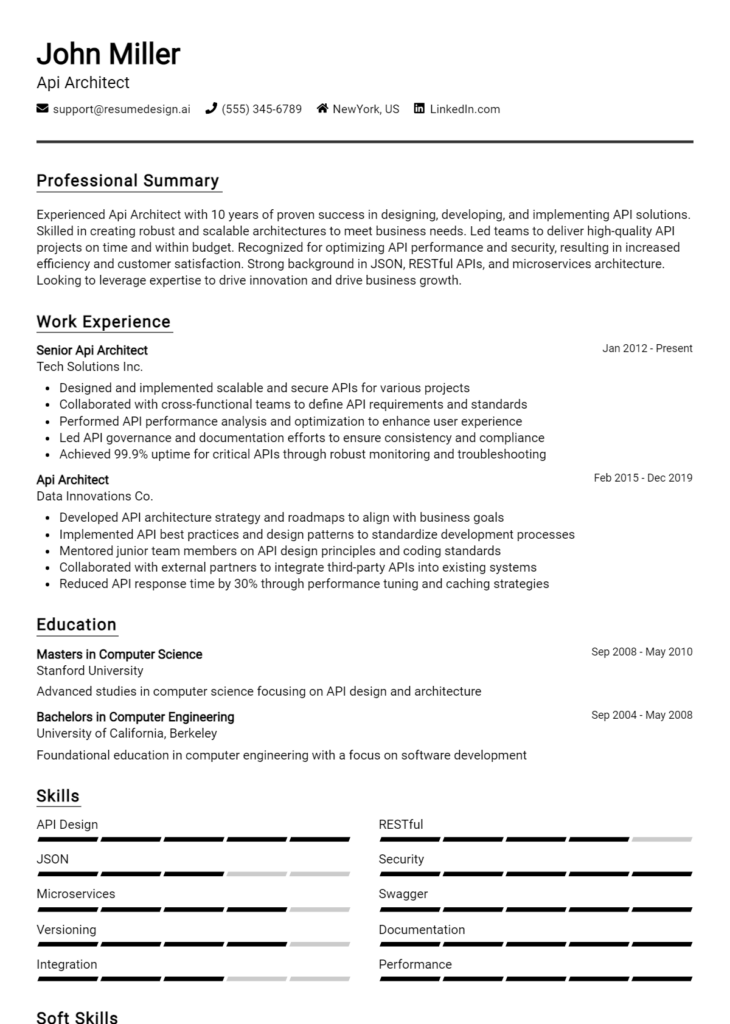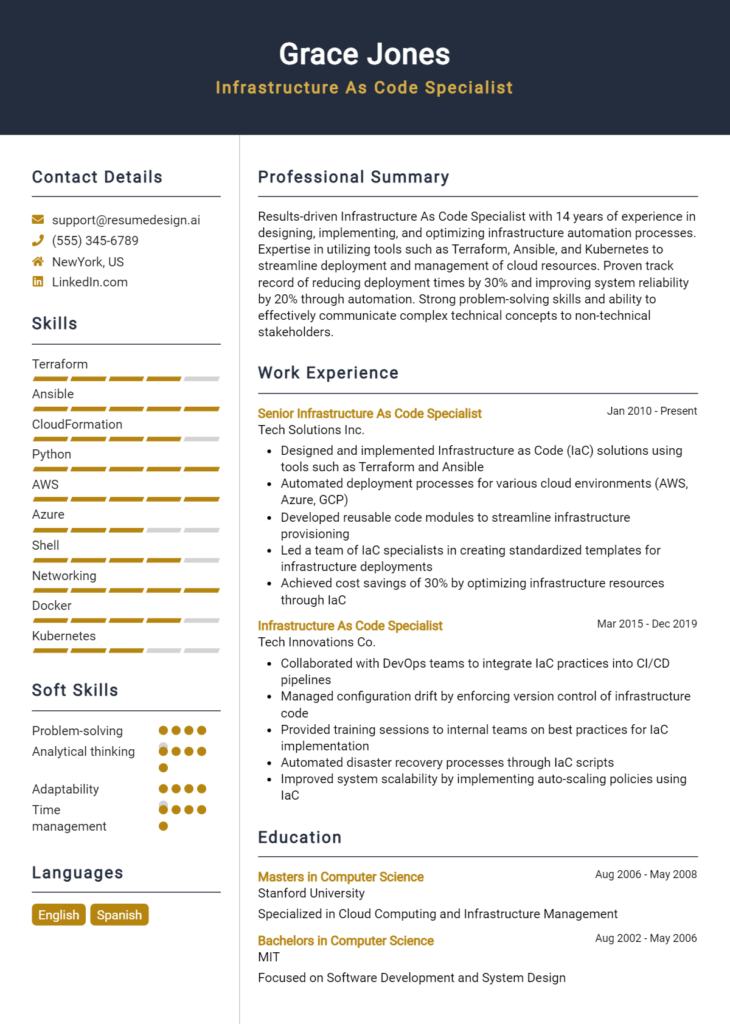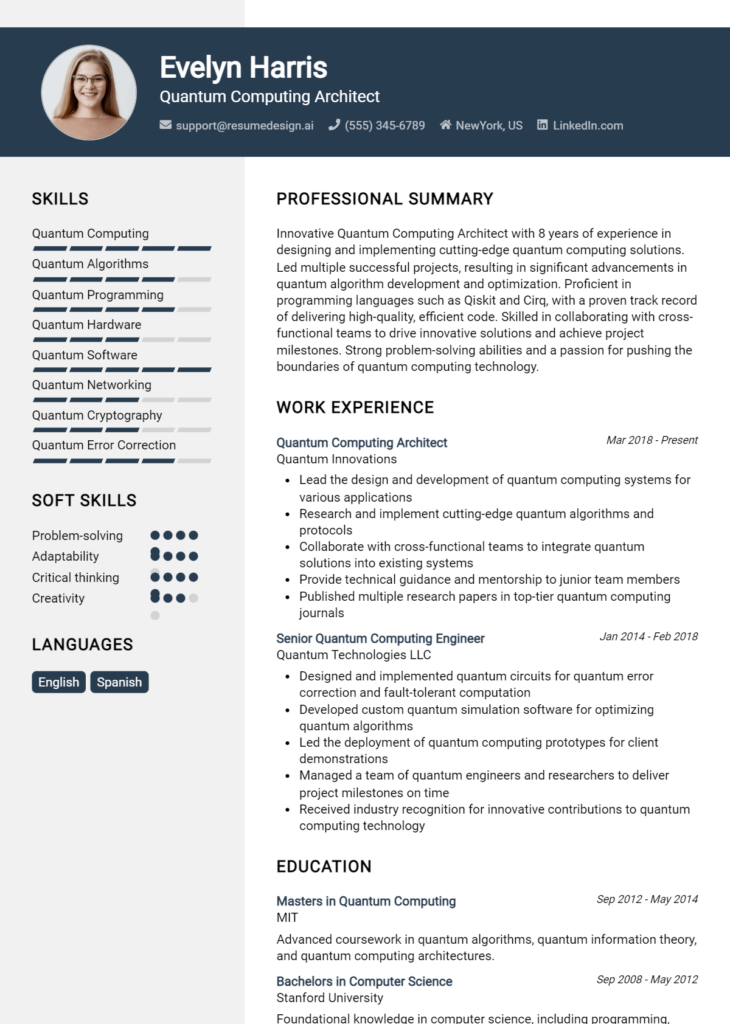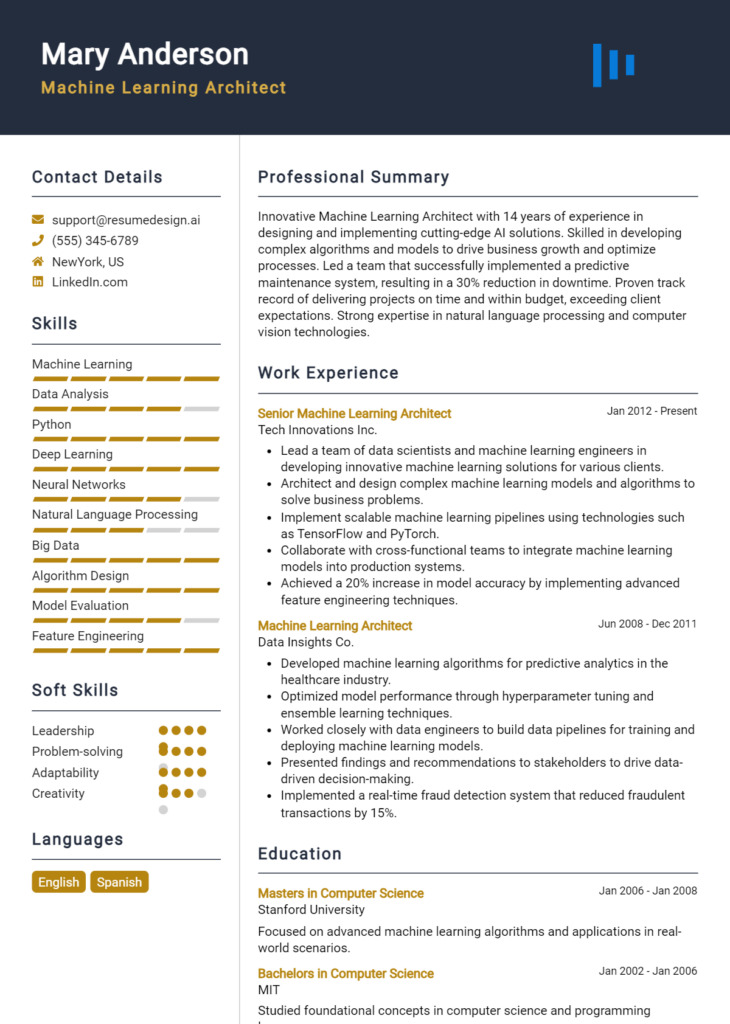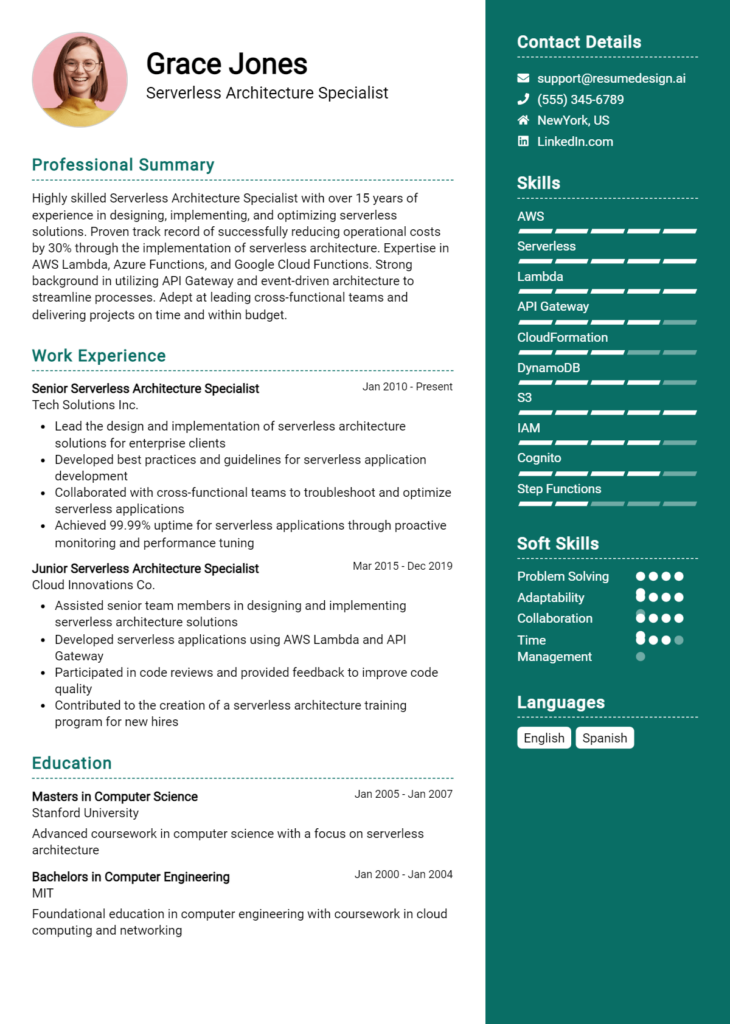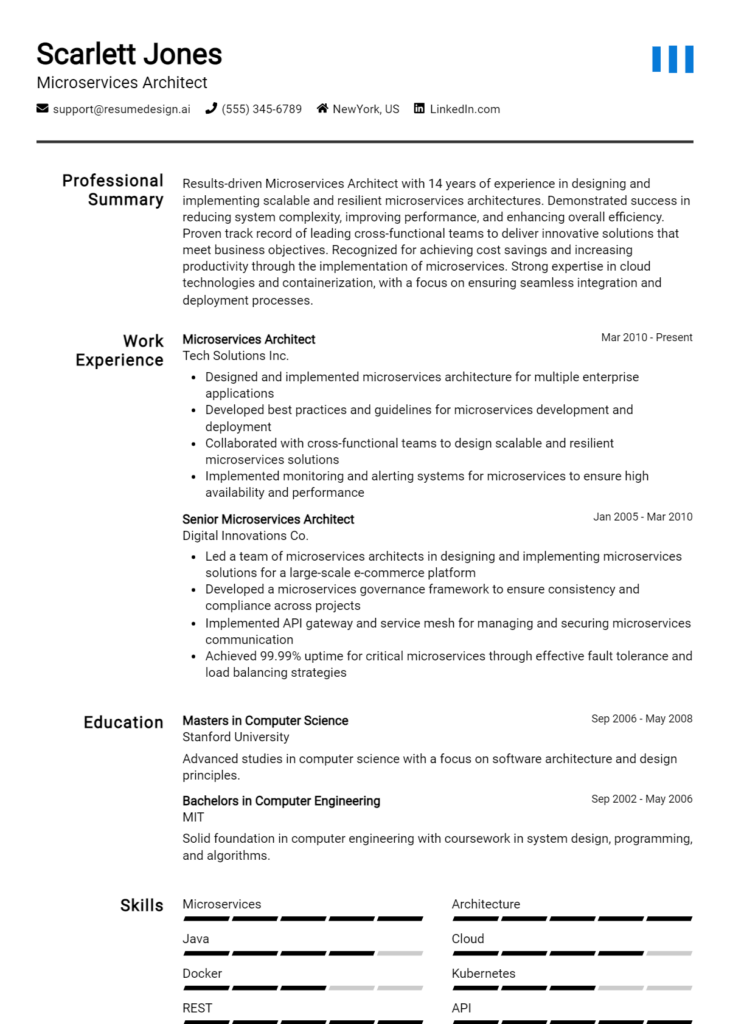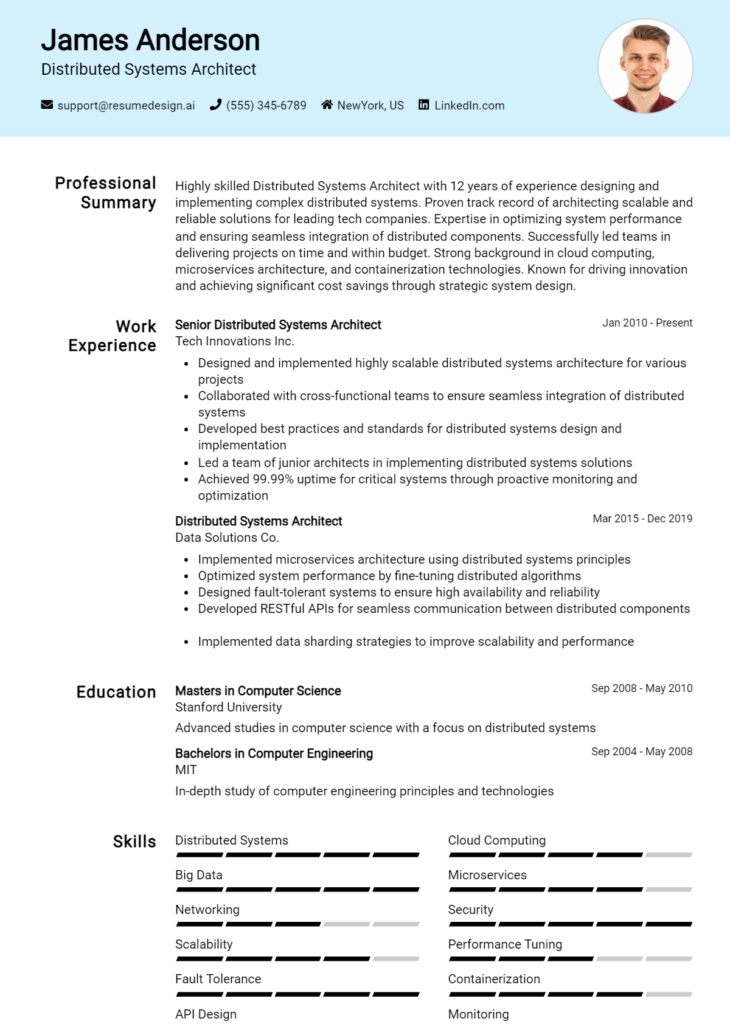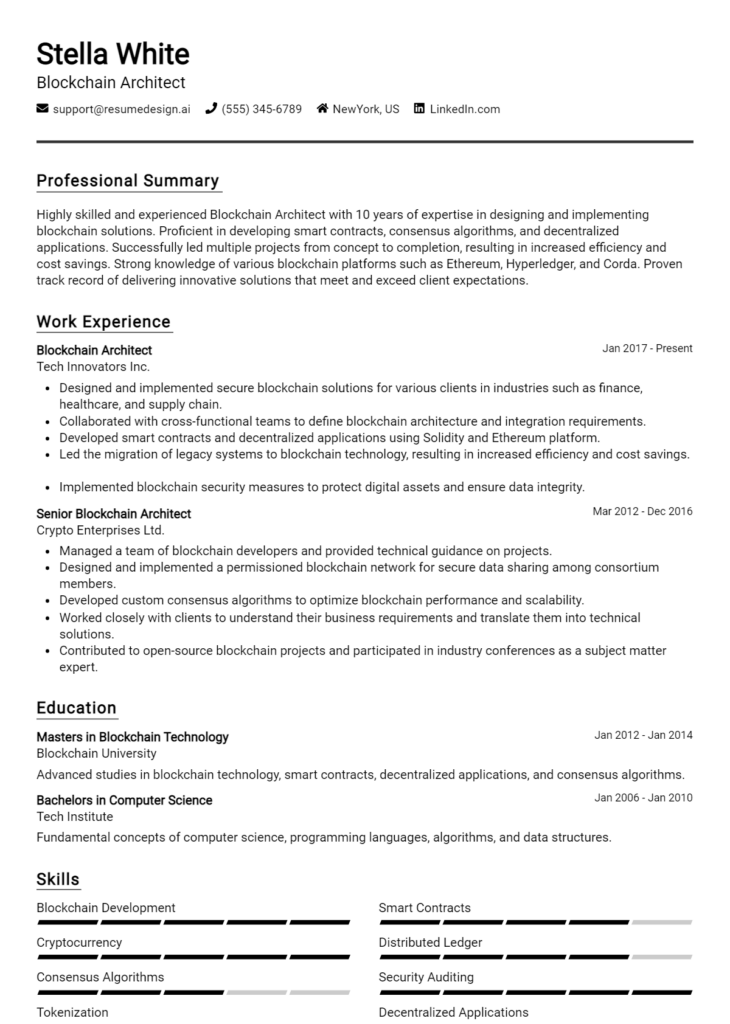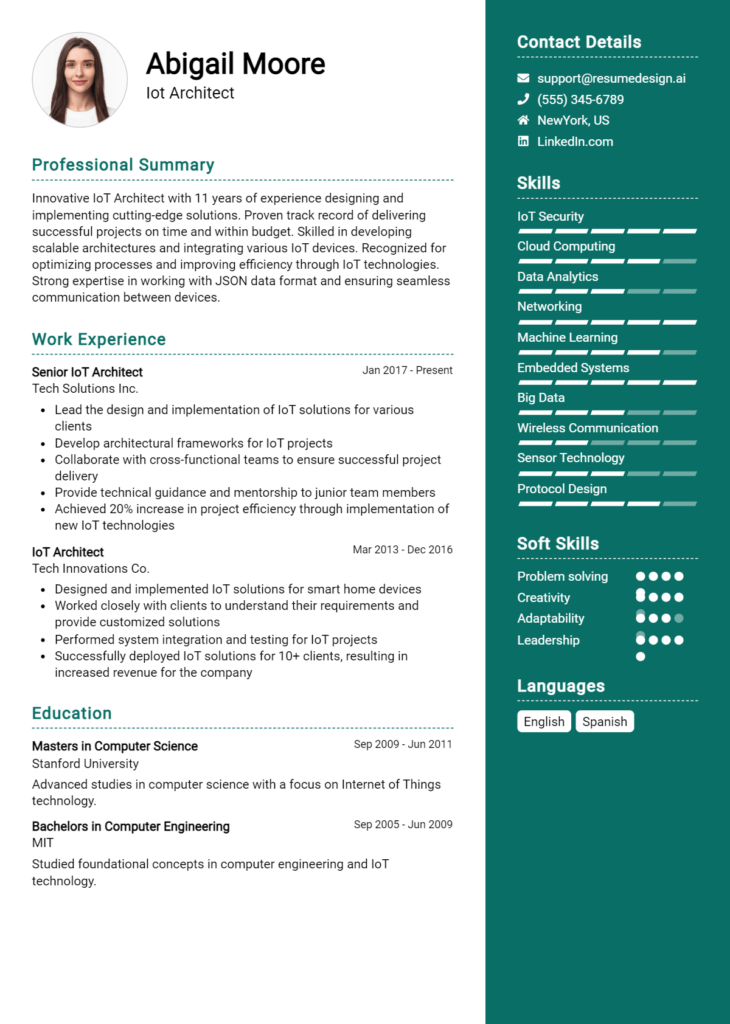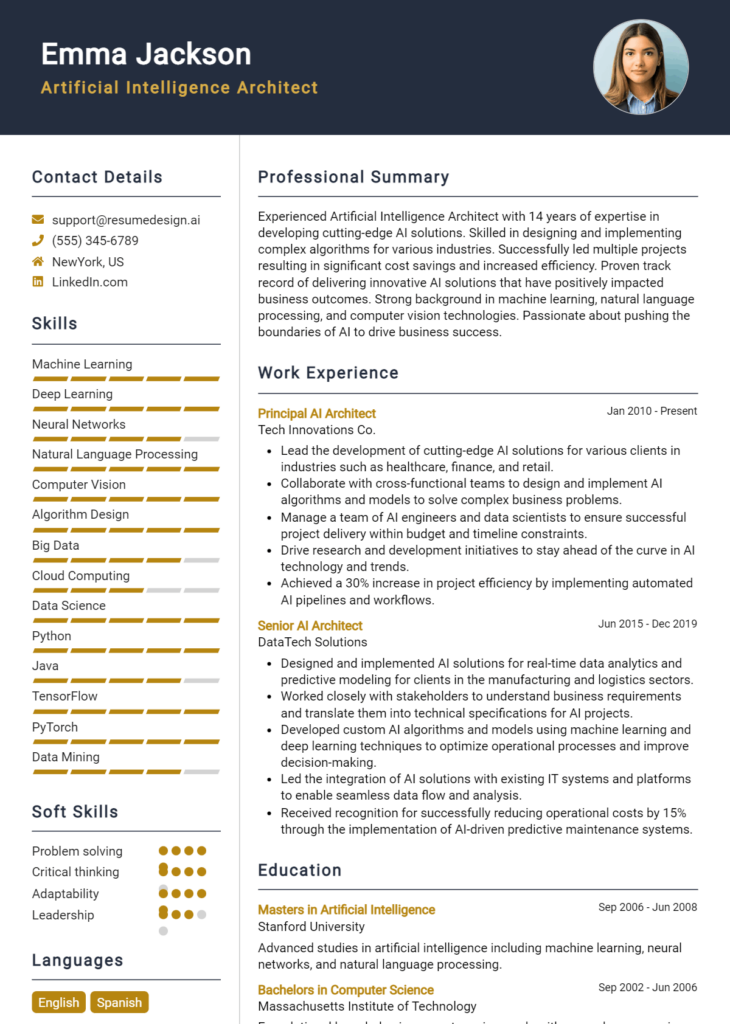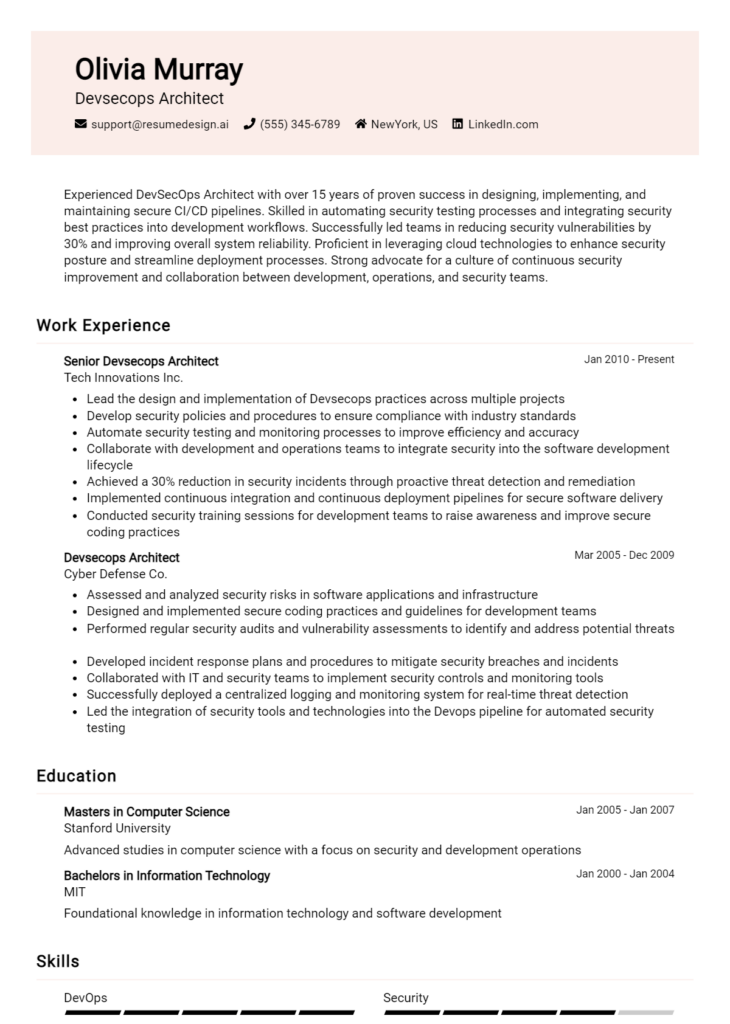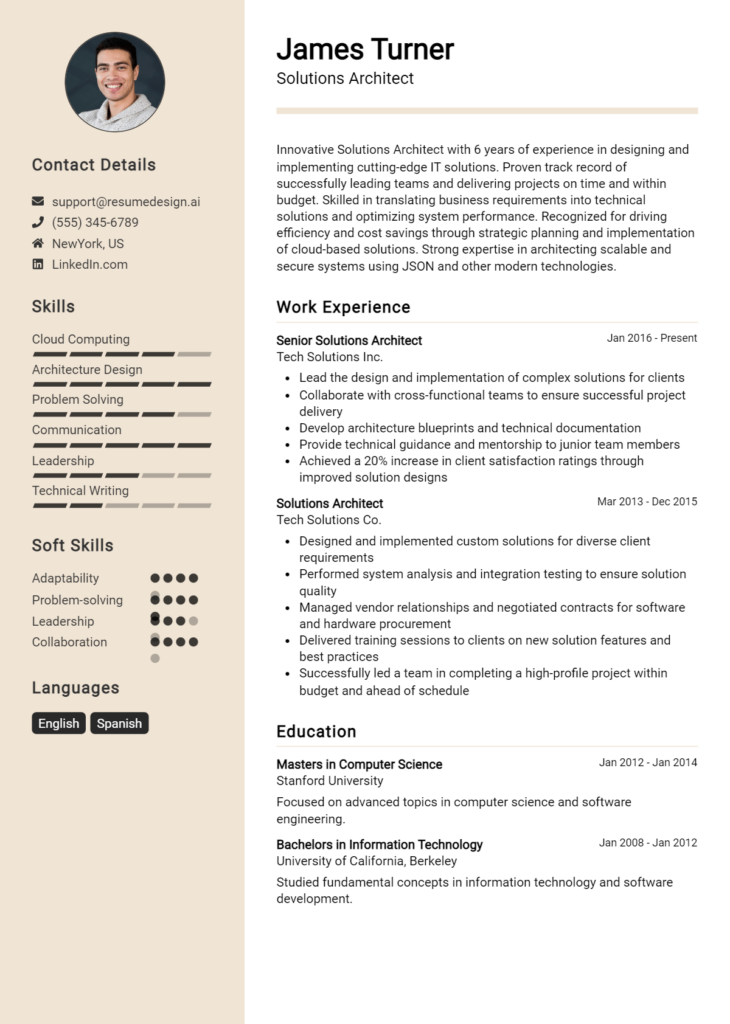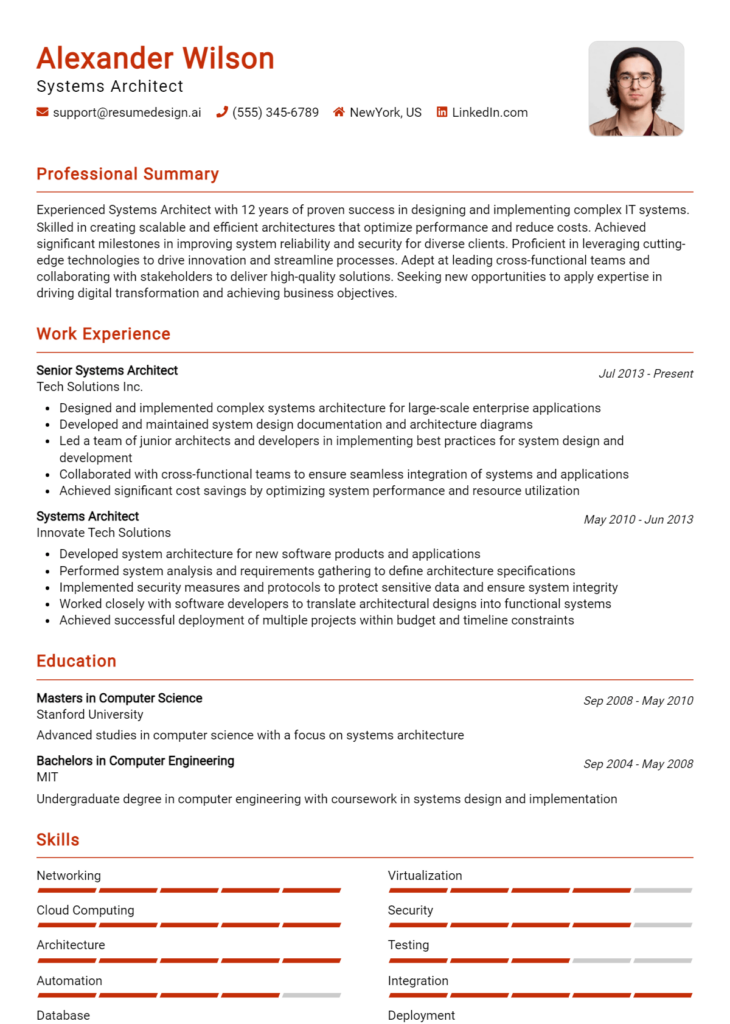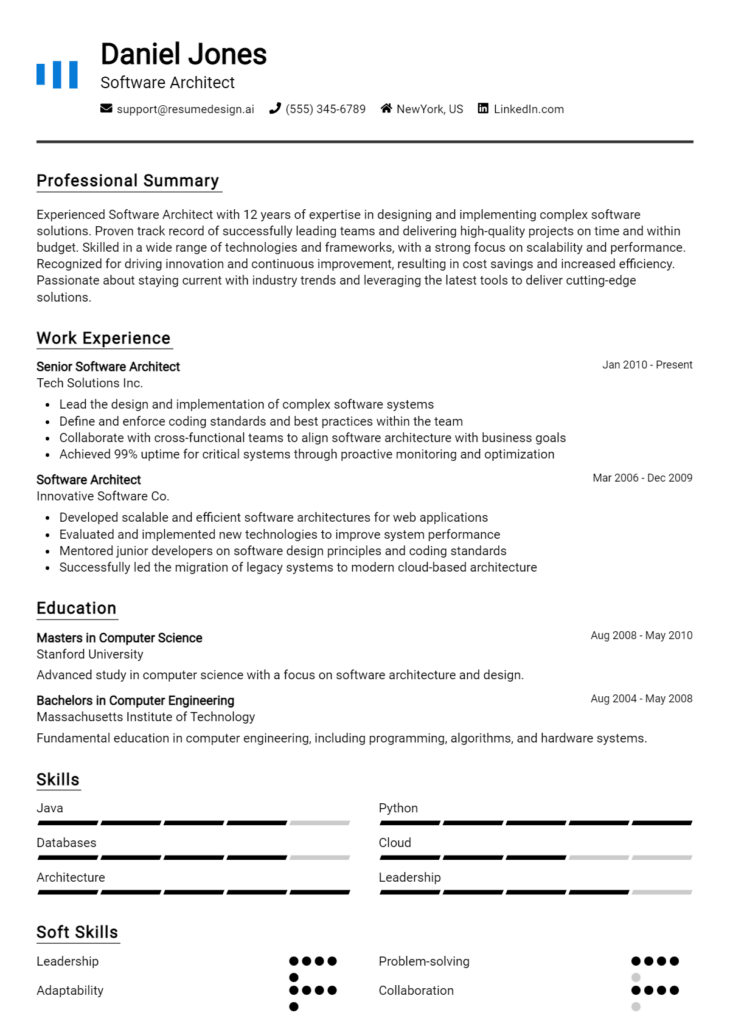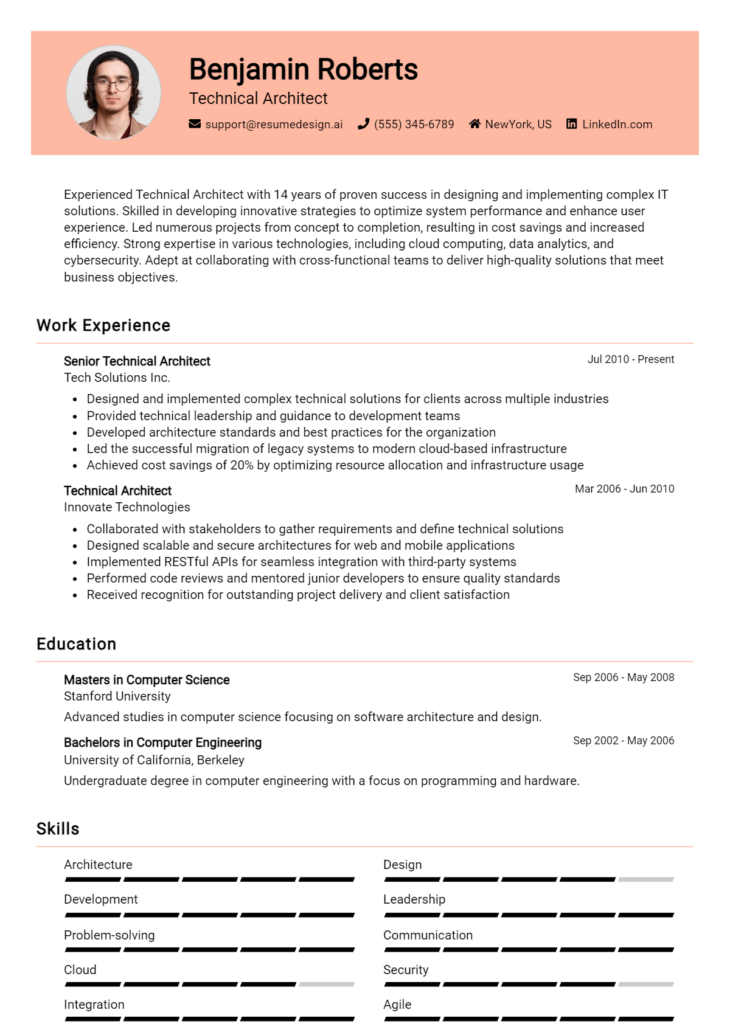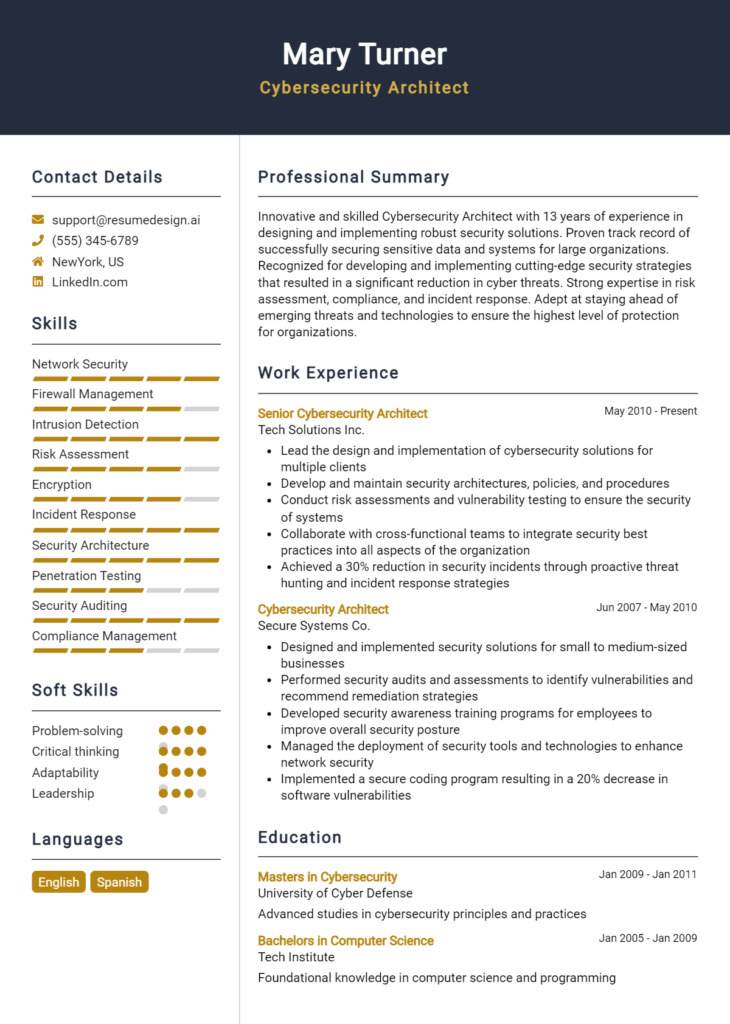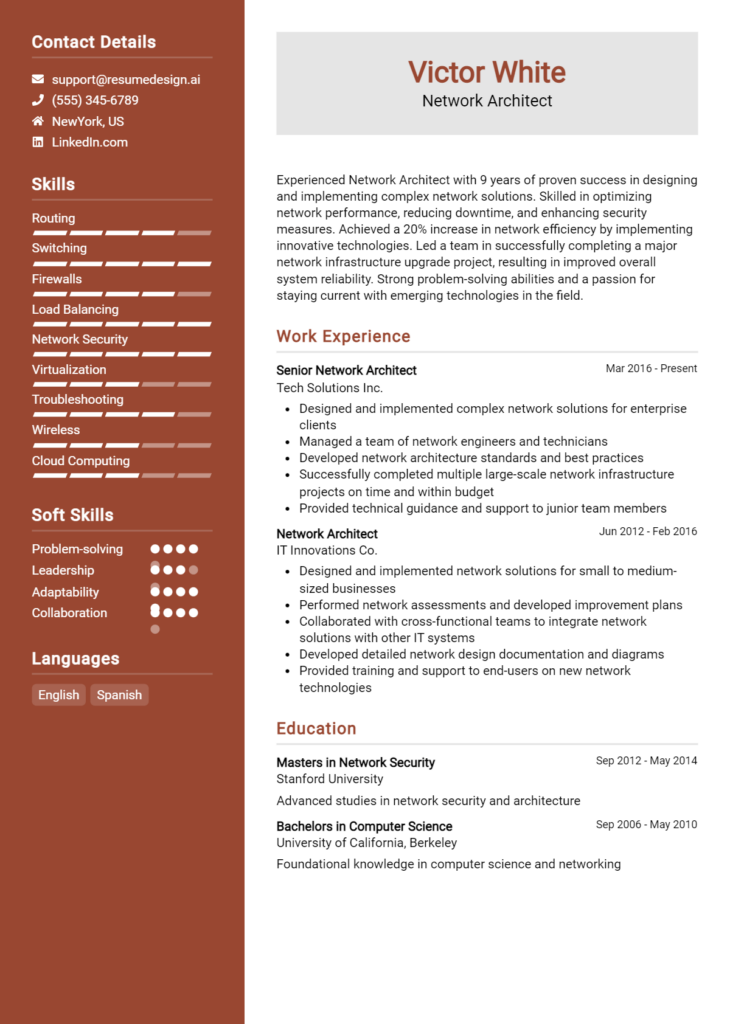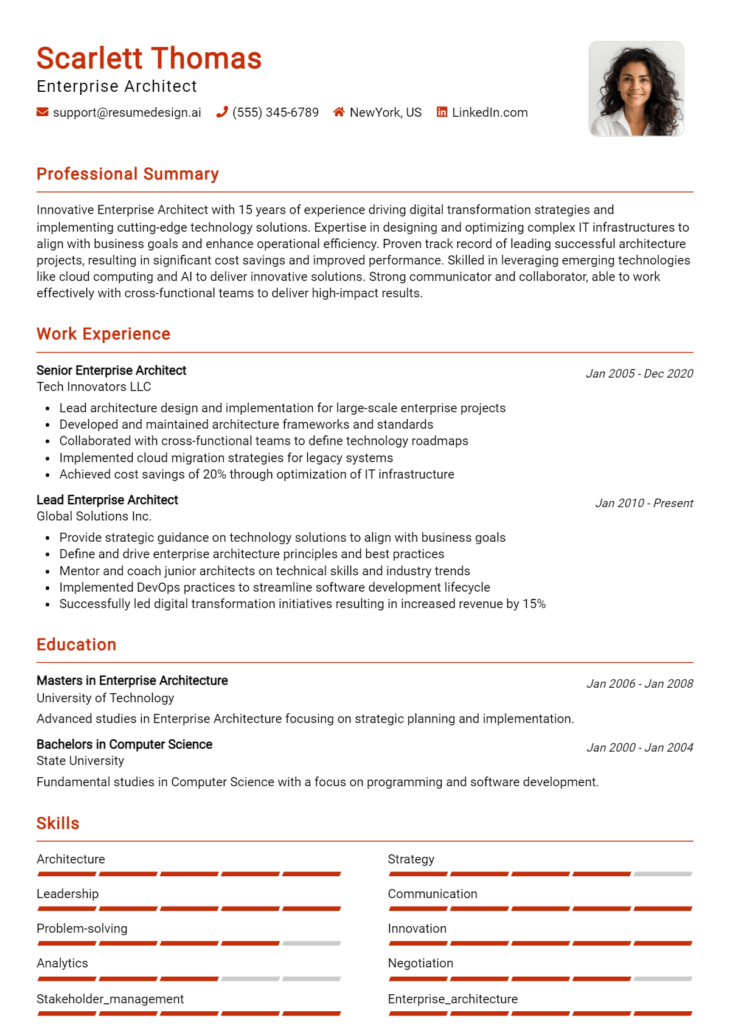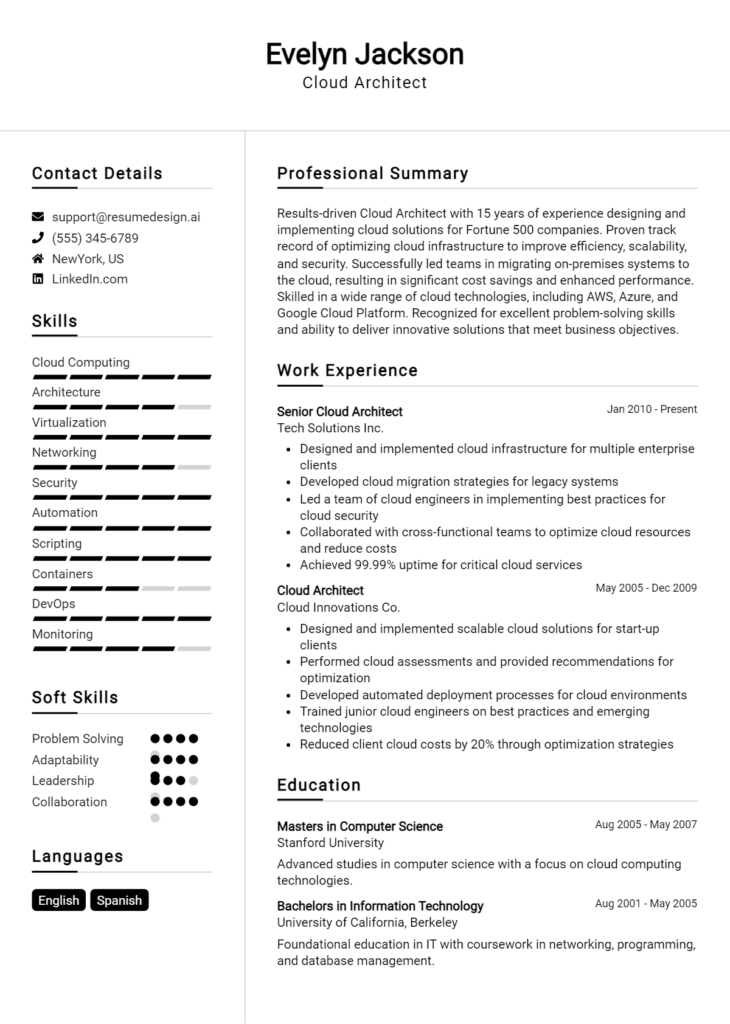Data Architect Core Responsibilities
A Data Architect plays a crucial role in designing and managing an organization’s data structure, serving as a bridge between various departments. Key responsibilities include developing data models, ensuring data integrity, and implementing data governance strategies. Essential skills encompass technical expertise in database management, operational insight for data utilization, and strong problem-solving abilities to tackle complex data challenges. These competencies contribute significantly to achieving organizational goals, and a well-structured resume can effectively showcase these qualifications to potential employers.
Common Responsibilities Listed on Data Architect Resume
- Designing and implementing data architecture solutions to meet business needs.
- Developing and maintaining data models and metadata repositories.
- Ensuring data quality and integrity across platforms.
- Collaborating with stakeholders to define data requirements and standards.
- Establishing data governance policies and procedures.
- Optimizing database performance and scalability.
- Integrating data from various sources for comprehensive analysis.
- Conducting data analysis to identify trends and insights.
- Providing technical guidance and mentorship to junior team members.
- Staying updated on emerging technologies and industry best practices.
- Documenting data architecture processes and policies.
High-Level Resume Tips for Data Architect Professionals
In the competitive landscape of data architecture, a well-crafted resume is an essential tool for professionals looking to stand out to potential employers. It serves as the first impression of your capabilities, skills, and achievements, making it crucial to present yourself in the best light possible. A compelling resume should not only highlight your technical expertise but also reflect your contributions to past projects and organizations. This guide aims to provide practical and actionable resume tips specifically tailored for Data Architect professionals, equipping you with the insights needed to create a standout resume that attracts the attention of hiring managers.
Top Resume Tips for Data Architect Professionals
- Tailor your resume to the specific job description, emphasizing the skills and experiences that align with the requirements of the position.
- Showcase relevant experience by detailing your role in data modeling, database design, and architecture projects.
- Quantify your achievements; include metrics that demonstrate the impact of your work, such as improved performance or cost savings.
- Highlight industry-specific skills, such as expertise in cloud platforms, data warehousing, and big data technologies.
- Utilize keywords from the job description to enhance the chances of passing through applicant tracking systems.
- Include certifications relevant to data architecture, such as AWS Certified Solutions Architect or Microsoft Certified: Azure Data Engineer.
- Incorporate a summary statement that succinctly captures your professional background and career objectives.
- Focus on your problem-solving abilities, illustrating how you have addressed complex data challenges in past roles.
- Maintain a clean, professional format that is easy to read and visually appealing, avoiding clutter and excessive graphics.
By implementing these tips, you can significantly increase your chances of landing a job in the Data Architect field. A targeted and well-structured resume not only showcases your qualifications but also demonstrates your understanding of the industry's demands, ultimately making you a more attractive candidate to potential employers.
Why Resume Headlines & Titles are Important for Data Architect
In the competitive field of data architecture, a resume headline or title plays a crucial role in capturing the attention of hiring managers. It serves as the first impression of a candidate's qualifications and expertise, summarizing their key strengths in a single, impactful phrase. A strong headline can set the tone for the entire resume, making it essential for job seekers to craft a concise and relevant title that aligns with the position being applied for. By effectively communicating their core competencies, candidates can differentiate themselves from the competition and increase their chances of being noticed.
Best Practices for Crafting Resume Headlines for Data Architect
- Keep it concise: Limit your headline to a single phrase or sentence.
- Make it role-specific: Tailor the headline to reflect the specific data architect position you are applying for.
- Highlight key skills: Include important skills or technologies relevant to data architecture.
- Use impactful language: Choose strong action verbs and adjectives that convey confidence and expertise.
- Include years of experience: If applicable, mention your experience level to establish credibility.
- Avoid jargon: Use clear and straightforward language that is easily understood.
- Be unique: Differentiate yourself by avoiding common phrases and clichés.
- Reflect your achievements: If possible, include a notable accomplishment to showcase your value.
Example Resume Headlines for Data Architect
Strong Resume Headlines
"Innovative Data Architect with 10+ Years of Experience in Cloud Solutions and Big Data Management"
“Results-Driven Data Architect Specializing in Data Warehousing and ETL Processes”
“Certified Data Architect with Proven Track Record in Designing Scalable Data Solutions”
Weak Resume Headlines
“Data Architect Looking for Opportunities”
“Experienced Professional in Data”
Strong headlines are effective because they succinctly communicate the candidate's qualifications, skills, and specific areas of expertise, making it easy for hiring managers to assess fit at a glance. In contrast, weak headlines fail to impress due to their vagueness and lack of specificity, leaving hiring managers with little information to gauge the candidate's suitability for the role. A compelling headline serves as a powerful marketing tool for job seekers, highlighting what sets them apart in a crowded job market.
Writing an Exceptional Data Architect Resume Summary
A resume summary is a critical component for a Data Architect, as it serves as the first impression to hiring managers scanning through numerous applications. A well-crafted summary quickly captures attention by highlighting key skills, relevant experience, and notable accomplishments that align with the specific job role. This concise and impactful introduction not only sets the tone for the rest of the resume but also positions the candidate as a strong fit for the position, making it essential to tailor this section to each job application.
Best Practices for Writing a Data Architect Resume Summary
- Quantify achievements: Include specific metrics or outcomes that demonstrate your impact in previous roles.
- Focus on relevant skills: Highlight technical skills and tools that are pertinent to the Data Architect role.
- Tailor to the job description: Customize your summary to reflect the qualifications and experiences the employer is seeking.
- Keep it concise: Aim for 3-4 sentences that deliver your key messages without overwhelming the reader.
- Use action-oriented language: Start sentences with strong action verbs to convey confidence and proactivity.
- Showcase industry experience: Mention specific industries where you have applied your data architecture skills effectively.
- Highlight problem-solving abilities: Emphasize your capability to address complex data challenges and implement effective solutions.
- Include certifications and education: Mention any relevant certifications or degrees that enhance your qualifications for the role.
Example Data Architect Resume Summaries
Strong Resume Summaries
Results-driven Data Architect with over 8 years of experience in designing scalable data solutions, achieving a 30% increase in data processing efficiency for a leading financial services firm. Skilled in AWS, SQL, and data modeling, with a proven track record of implementing data governance frameworks that reduced data discrepancies by 25%.
Dynamic Data Architect proficient in Big Data technologies, including Hadoop and Spark, with a strong background in cloud-based data warehousing. Successfully led a team to migrate legacy systems to a new data architecture, resulting in a savings of $200,000 annually in operational costs.
Innovative Data Architect with expertise in ETL processes and data visualization, demonstrated by a 15% improvement in reporting accuracy for a major retail client. Adept at collaborating with cross-functional teams to design data solutions that drive business intelligence and support strategic initiatives.
Weak Resume Summaries
Experienced Data Architect looking for a challenging role in a dynamic environment where I can utilize my skills.
Data Architect with some experience in data management and analytics. I am a team player and can help organizations achieve their goals.
The strong resume summaries are effective because they provide clear, quantifiable achievements and specific skills that directly relate to the Data Architect role, making the candidates stand out. In contrast, the weak summaries lack detail and specificity, failing to convey the candidate's value or show measurable outcomes, which may lead hiring managers to overlook them in favor of more compelling candidates.
Work Experience Section for Data Architect Resume
The work experience section of a Data Architect resume is critical as it serves as a platform to demonstrate the candidate's technical acumen, leadership capabilities, and their track record in delivering high-quality data solutions. This section not only highlights the individual's specific skills in data architecture, data modeling, and database management but also showcases their ability to lead teams and collaborate effectively with other departments. By quantifying achievements and aligning experiences with industry standards, candidates can significantly enhance their attractiveness to potential employers, illustrating their contributions to previous organizations and the impact of their work.
Best Practices for Data Architect Work Experience
- Use specific technical terminology relevant to data architecture to showcase expertise.
- Quantify achievements with metrics, such as percentage improvements and cost savings.
- Highlight collaborative projects that demonstrate teamwork and leadership abilities.
- Include a mix of project types to display versatility across various technologies and methodologies.
- Focus on outcomes and the impact of your work on business goals.
- Keep descriptions concise but detailed enough to convey the significance of your role.
- Align experiences with current industry trends and standards to show relevance.
- Tailor your work experience to match the job description for each application.
Example Work Experiences for Data Architect
Strong Experiences
- Led the design and implementation of a data warehouse solution that improved reporting efficiency by 40%, resulting in faster decision-making for senior management.
- Managed a cross-functional team of 10 data engineers and analysts to develop a real-time data processing pipeline that reduced data latency by 50%.
- Architected a cloud-based data integration platform that lowered operational costs by 30% while enhancing data accessibility across departments.
- Collaborated with stakeholders to create a comprehensive data governance framework, ensuring compliance and improving data quality by 25%.
Weak Experiences
- Worked on data-related projects that involved various tasks.
- Assisted in team efforts to improve data systems.
- Participated in meetings about data architecture.
- Helped with the maintenance of databases.
The examples provided illustrate a clear distinction between strong and weak experiences. Strong experiences are characterized by specific, quantifiable outcomes that demonstrate effective leadership, collaboration, and technical expertise. They provide concrete evidence of the candidate's impact on previous organizations through measurable results. In contrast, weak experiences lack detail and specificity, failing to showcase the candidate's contributions or the significance of their roles, which diminishes their potential appeal to employers.
Education and Certifications Section for Data Architect Resume
The education and certifications section of a Data Architect resume plays a crucial role in showcasing a candidate's academic background, industry-relevant certifications, and commitment to continuous learning. This section not only highlights the foundational knowledge acquired through formal education but also emphasizes specialized training and certifications that demonstrate proficiency in data architecture and related technologies. By providing relevant coursework and recognized credentials, candidates can significantly enhance their credibility and alignment with the specific requirements of the Data Architect role, making them stand out in a competitive job market.
Best Practices for Data Architect Education and Certifications
- Prioritize relevant degrees, such as Computer Science, Information Technology, or Data Science.
- Include industry-recognized certifications like AWS Certified Solutions Architect, Microsoft Certified: Azure Data Engineer Associate, or Google Cloud Professional Data Engineer.
- Highlight advanced coursework in data modeling, database management, and big data technologies.
- List certifications in emerging technologies, such as data warehousing, machine learning, or artificial intelligence.
- Be specific about the completion dates for degrees and certifications to demonstrate recent knowledge.
- Group certifications by relevance or technology stack to make it easier for hiring managers to review.
- Include any hands-on training or workshops that complement formal education and demonstrate practical experience.
- Keep the section concise yet informative, focusing on quality over quantity.
Example Education and Certifications for Data Architect
Strong Examples
- M.S. in Computer Science, University of California, Berkeley, 2021
- AWS Certified Solutions Architect – Associate, 2022
- Certified Data Management Professional (CDMP), 2023
- Relevant Coursework: Data Warehousing, Advanced SQL, and Big Data Analytics.
Weak Examples
- Bachelor of Arts in English Literature, University of Texas, 2017
- Certification in Basic Computer Skills, 2018
- Outdated Oracle Certified Professional, 2015
- Relevant Coursework: Introduction to Psychology.
The strong examples are considered relevant as they directly align with the skills and knowledge required for a Data Architect role, showcasing advanced degrees and current industry certifications. In contrast, the weak examples are deemed irrelevant or outdated, as they do not pertain to data architecture or the necessary technical expertise, which could hinder a candidate's chances of being recognized as a suitable fit for the position.
Top Skills & Keywords for Data Architect Resume
A well-crafted resume is essential for a Data Architect, as it serves as the first impression to potential employers. Highlighting the right skills is crucial, as they demonstrate your ability to design and manage complex data systems effectively. Employers look for candidates who not only have technical expertise but also possess the soft skills necessary for collaboration, problem-solving, and strategic thinking. A strong emphasis on relevant skills can set you apart in a competitive job market, making it vital to showcase both hard and soft skills prominently on your resume.
Top Hard & Soft Skills for Data Architect
Soft Skills
- Analytical Thinking
- Problem Solving
- Communication Skills
- Team Collaboration
- Adaptability
- Leadership
- Attention to Detail
- Strategic Planning
- Time Management
- Critical Thinking
Hard Skills
- Data Modeling
- Database Design
- ETL (Extract, Transform, Load) Processes
- SQL and NoSQL Databases
- Data Warehousing Solutions
- Cloud Computing Platforms (e.g., AWS, Azure)
- Big Data Technologies (e.g., Hadoop, Spark)
- Data Governance and Compliance
- Performance Tuning
- Data Integration Techniques
Emphasizing these skills on your resume will not only enhance your qualifications but also align your experience with the expectations of employers in the data architecture field. For more guidance, consider reviewing how to effectively showcase your work experience to complement these skills.
Stand Out with a Winning Data Architect Cover Letter
Dear Hiring Manager,
I am excited to apply for the Data Architect position at [Company Name], as advertised on [Job Board/Company Website]. With a robust background in data modeling, database design, and cloud architecture, I am confident in my ability to contribute significantly to your team. My experience includes over [X years] of working in various industries, where I have successfully developed and implemented data solutions that enhance operational efficiency and drive strategic decision-making.
In my previous role at [Previous Company Name], I led a team in designing a scalable data architecture that improved data accessibility and integrity across the organization. By collaborating with cross-functional teams, I identified data silos and implemented a centralized data warehouse solution, resulting in a [X%] increase in reporting efficiency. Additionally, my proficiency in [specific technologies or tools, e.g., AWS, Azure, SQL, etc.] has enabled me to optimize data pipelines and ensure seamless integration with existing systems.
I am particularly drawn to [Company Name] due to its commitment to innovation and excellence in data management. I am eager to bring my expertise in developing data governance frameworks and ensuring compliance with industry standards to your esteemed organization. I believe that my passion for leveraging data to drive business insights aligns perfectly with your goals, and I look forward to the opportunity to contribute to [specific project or initiative related to the company].
Thank you for considering my application. I am enthusiastic about the possibility of discussing how my skills and experience can benefit [Company Name]. I look forward to the opportunity to speak with you further about my candidacy.
Sincerely,
[Your Name]
[Your LinkedIn Profile or Website]
[Your Contact Information]
Common Mistakes to Avoid in a Data Architect Resume
When crafting a resume for a Data Architect position, it's crucial to present your skills and experiences effectively to stand out in a competitive job market. Many candidates make common mistakes that can detract from their qualifications, leading to missed opportunities. By being aware of these pitfalls, you can enhance your resume and showcase your expertise in data architecture more effectively.
Lack of Focus on Technical Skills: Failing to highlight relevant technical skills, such as proficiency in databases (SQL, NoSQL), data modeling, and ETL processes, can make your resume less appealing to hiring managers who prioritize these competencies.
Overly Complex Language: Using jargon or overly technical language can confuse readers. It's important to strike a balance between showcasing your expertise and being clear and concise in your descriptions.
Ignoring Project Impact: Simply listing responsibilities without discussing the impact of your work can weaken your resume. Quantifying achievements, such as cost savings or performance improvements, can demonstrate your value effectively.
Inconsistent Formatting: A disorganized or inconsistent format can make your resume difficult to read. Ensure that headings, bullet points, and font sizes are uniform throughout the document to maintain a professional appearance.
Omitting Soft Skills: While technical skills are vital, soft skills like communication, teamwork, and problem-solving are equally important. Highlighting these can show your ability to collaborate with stakeholders and lead teams.
Using a Generic Template: Submitting a one-size-fits-all resume can lead to missed opportunities. Tailor your resume to the specific job description, emphasizing the skills and experiences that align with the role.
Neglecting Continuous Learning: In a field that evolves rapidly, failing to mention ongoing education, certifications, or workshops can signal stagnation. Showcasing your commitment to professional growth can set you apart from other candidates.
Poorly Listed Work Experience: Listing work experience without context or relevance can diminish its impact. Focus on roles that relate to data architecture and provide specific examples of your contributions and accomplishments in those positions.
Conclusion
In conclusion, the role of a Data Architect is crucial for organizations striving to harness the power of data effectively. Key responsibilities include designing robust data models, ensuring data integrity, and developing strategies for data storage and retrieval. Additionally, a Data Architect must collaborate with various teams to align data solutions with business objectives. As the demand for skilled Data Architects continues to grow, having a well-crafted resume is essential to stand out in a competitive job market.
Now is the perfect time to review and enhance your Data Architect resume. Utilize available resources to create an impactful presentation of your skills and experience. Explore resume templates to find a design that suits your style, or use the resume builder for a guided approach to crafting your resume. Additionally, check out resume examples for inspiration and cover letter templates to complement your application. Take action today to ensure your qualifications shine through!

